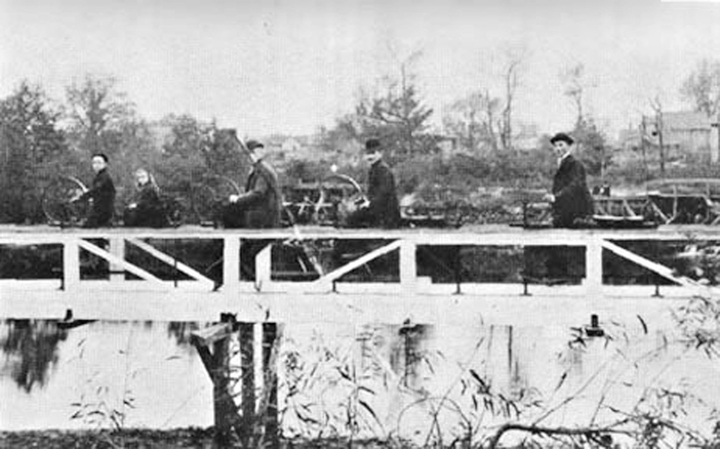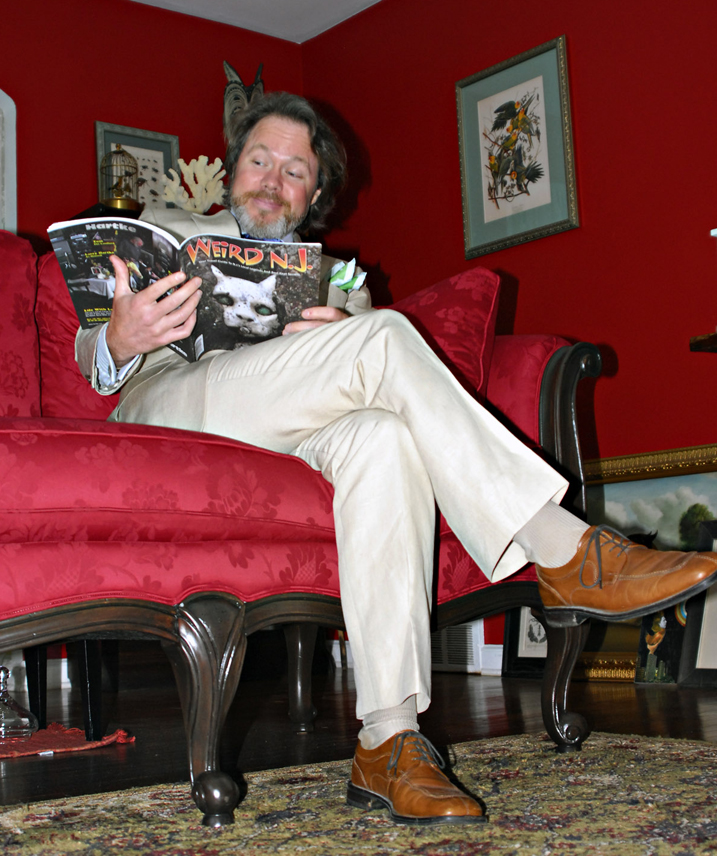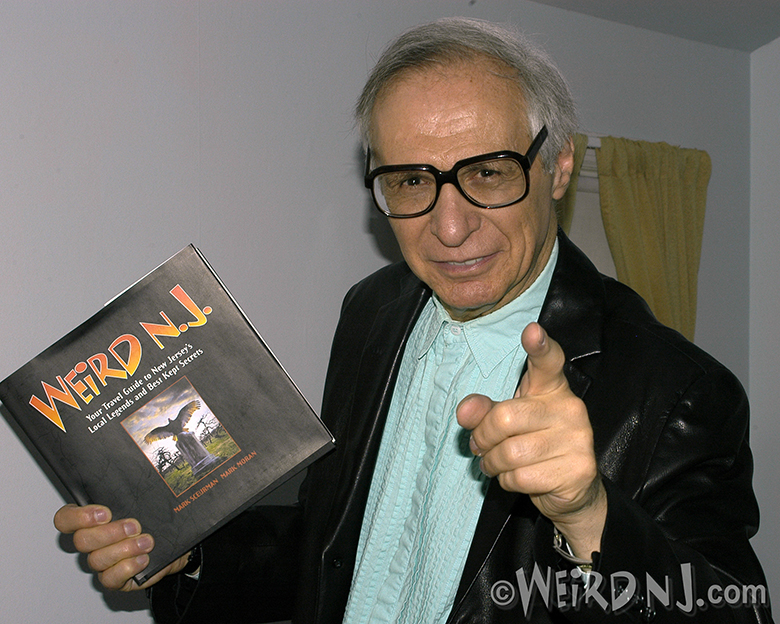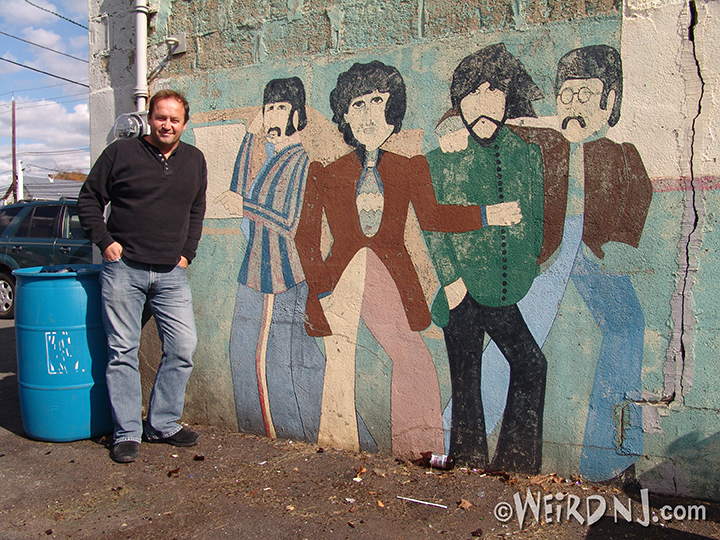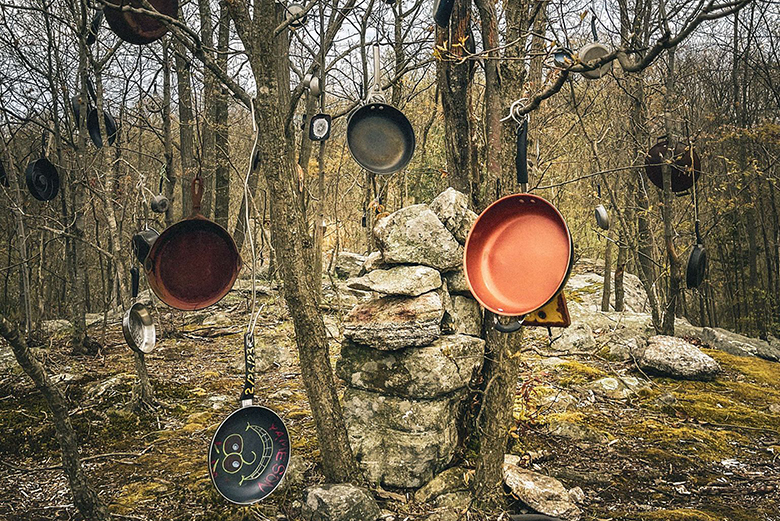Lord Whimsy: Weirdo Advocate
Fill a garden with carnivorous plants and you’re likely to raise Weird interest, though there usually has to be more to keep our attention. In the case of Lord Whimsy—long-time South Jerseyan; rider of highwheel bikes; raiser of moths and orchids; and an overall enthusiast of art, clothing, literature, botany, and aesthetics—meat-eating vegetation was tip of the dandy iceberg. We found plenty more of interest as we perused his book, The Affected Provincial’s Companion: Volume One (Bloomsbury, 2006) and website, lordwhimsy.com. It would be easy to call the content of both an über-literate guide on how to be a dandy, but it’s much more than that. With references to such diverse subject matter as Lucy the Elephant, serious facial hair grooming, and man antlers, a trip to the Whimsy bungalow in Mt. Holly was in order.
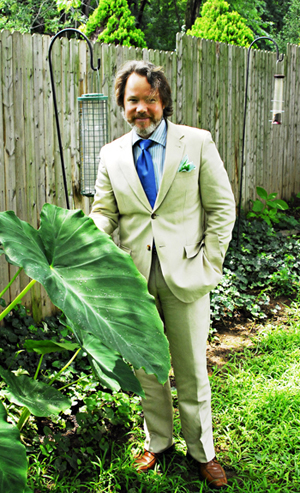 Lord Whimsy greeted us outside, and true to affected provincial form he was dressed in a summer suit, with a tie and a pocket square in shades of green that didn’t exactly match. Inside, we met his wife, Lady Pinkwater, and the two invited us to have snacks and tour their home and yard (complete with the aforementioned carnivorous garden) before the interview. And we talked about many topics, including a few we had to leave out for space: local characters who live in New Egypt and along the Rancocas River, the Metz Bicycle museum in Freehold, emotionally needy flora, and the dying breed of piss troughs. What follows is a whimsical distillation of an interview with a self-described “Weirdo Advocate.”
Lord Whimsy greeted us outside, and true to affected provincial form he was dressed in a summer suit, with a tie and a pocket square in shades of green that didn’t exactly match. Inside, we met his wife, Lady Pinkwater, and the two invited us to have snacks and tour their home and yard (complete with the aforementioned carnivorous garden) before the interview. And we talked about many topics, including a few we had to leave out for space: local characters who live in New Egypt and along the Rancocas River, the Metz Bicycle museum in Freehold, emotionally needy flora, and the dying breed of piss troughs. What follows is a whimsical distillation of an interview with a self-described “Weirdo Advocate.”
Joanne Austin: The Affected Provincial’s Almanac started as a column in the Philadelphia Independent?
Lord Whimsy: Yes, it was. Well, it started before that, as an exercise that I was doing on my own just to amuse myself. I’m a designer and illustrator by trade: I’m not trained as a writer. I’ve had the same rudimentary English Literature classes that most people who go through high school have so beyond that I haven’t had much background other than my own independent reading. So I was basically too ignorant to know any better, I suppose, and I went ahead and played with the form anyway. I had ideas that I’d been playing around with for some time but I was really taken by eighteenth and nineteenth century pseudo-authoritative charts: Moral thermometers and things like that. The sort of thing you would find in texts like Poor Richard’s Almanack.
JA: In reading the book and your website, I felt there are a lot of things going on that Weird NJ readers would enjoy, which is why I put the wheels in motion to talk with you. But in having done that, I now see there’s a lot more to it than what I originally came across.
LW: That’s the whole idea. I’m throwing up this obvious mask that people discount as a gimmick. And if that’s what they want to take away from it, that’s fine, but someone who wants to dig a little deeper can do that. I like throwing it out there and tripping people up a little bit with their preconceptions. They think I’m going to be rolling my “Rs” and running around being overly theatrical and basically putting on an act.
There’s artifice there: don’t get me wrong. But the mask I wear fits the contours of my own personality. In a lot of ways I’m more real than, say, the professor, the doctor. Everybody has to wear their professional masks. I’m just being a little more overt about it. I get to create my mask. Not everybody has that luxury. And I get to keep the parts of my personality that way, where other people have to shear off of themselves or tuck behind the masks that they’re forced to wear daily to get by in life. So for me, it works out pretty well.
JA: The book is more of a personal folklore?
LW: Yes. I’m building up this sort of little constellation of personal emblems of mine. It’s like a mytho-poetic little ecosystem that I made for myself. There are points of references that I keep revisiting, there are constant themes in what I’m doing and it’s grown an awful lot since the book was put out. It was being put together between 2002 and 2005 and is a bit of a time capsule in that regard. I don’t think I’d be able to write the same book again. The book I’m working on right now isn’t going to be like that at all. It’s not necessarily me inhabiting this little world or persona and never venturing outside of that. It’s more of an ongoing thing. The mask just allows people into the world and then they have to travel along. But that’s not the sum of the thing. The mask is a door that lets you and then you realize, “Oh, okay.”
JA: We’ve never gotten a letter or an email from anyone saying “Oh, there’s this guy in Mt. Holly, he rides around on a velocipede, he wears these clothes that not everyone wears. You mention in the book about how it’s more of a subtle thing you seem to have mastered, as opposed to Underdog Lady, who’s not subtle.
LW: Yes, but don’t get me wrong. I love Underdog Lady. I remember seeing her in the parades in Ocean City when I was a little kid.
Ryan Doan: She’s an icon.
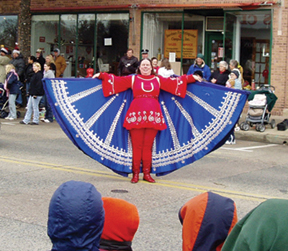 LW: God bless Underdog Lady. I think she’s wonderful. And all of those people out there—the Tiny Tims of the world—I would fall on my sword in defending any of them. I think they’re all wonderful things. Unfortunately I’m a little more normal than that. I wish I was that interesting, but those people are true eccentrics. I’m just a little weird, that’s all. I’m a functioning eccentric: I can still get along in the world.
LW: God bless Underdog Lady. I think she’s wonderful. And all of those people out there—the Tiny Tims of the world—I would fall on my sword in defending any of them. I think they’re all wonderful things. Unfortunately I’m a little more normal than that. I wish I was that interesting, but those people are true eccentrics. I’m just a little weird, that’s all. I’m a functioning eccentric: I can still get along in the world.
In some ways, I feel like I’m the intermediary between the straight world and my eccentric friends. If I’m walking down the street with them and they’re outright freaks and I’m a relatively normalish person, it almost creates a buffer, like a metaphysical bodyguard. People won’t say anything if I’m there, they won’t be unkind to them. I have a real soft spot for people like that. I may not partake in the theatricality, but I’m very much on their side.
RD: They make life interesting.
LW: Someone like Underdog Lady, she’s a gift to the world. She may do it for her own reasons but at the end of the day, would you want to live in a world without her? I wouldn’t. Or live in a world where people like her aren’t possible? That’s the world were veering toward right now. That’s the scary thing. I’m a fairly average person…almost more of a weirdo conservationist rather than a weirdo myself. I’m like, “Leave these guys alone, let them do their thing, the world needs them, too.”
(Getting back to Whimsy) It started out in jest, but over time you grow into it and over time what happens is that you can’t get the mask off or people get upset if you take the mask off. They want a little cold star in the firmament that says, “You can go there if you want to.” It isn’t about me as a person, it isn’t because I’m so wonderful or anything like that. It’s just that people need that little emblem. They’ve invested in that and what happens is something that started as a joke or a little bit of a prank becomes an office.
JA: It’s not fun anymore.
 LW: Well, it isn’t so much it isn’t fun as it isn’t about self-aggrandizement or entertainment any more. It becomes about service. I’ve done weddings for people, and people are always asking me advice on clothes and plants. I’m going to do talks out at Bartram’s (Garden), I’m giving tours of the Pine Barrens, and all these things have come my way because of the “Whimsy” thing. But people are always asking things of you and you don’t want to let them down. They seem to need this witch doctor element that’s lacking right now, that the priests and shamans used to do. This weird little manifestation of the prankster god. They need some sort of creature that’s outside of the realm of normal, mainstream experience that they can still not feel weird about contacting or interacting with. Someone who can come in and hopefully enrich their lives, if you want to get grandiose about it. But that’s the whole idea, bringing people into a larger sphere.
LW: Well, it isn’t so much it isn’t fun as it isn’t about self-aggrandizement or entertainment any more. It becomes about service. I’ve done weddings for people, and people are always asking me advice on clothes and plants. I’m going to do talks out at Bartram’s (Garden), I’m giving tours of the Pine Barrens, and all these things have come my way because of the “Whimsy” thing. But people are always asking things of you and you don’t want to let them down. They seem to need this witch doctor element that’s lacking right now, that the priests and shamans used to do. This weird little manifestation of the prankster god. They need some sort of creature that’s outside of the realm of normal, mainstream experience that they can still not feel weird about contacting or interacting with. Someone who can come in and hopefully enrich their lives, if you want to get grandiose about it. But that’s the whole idea, bringing people into a larger sphere.
RD: It’s similar to what the magazine does.
LW: Yes, it’s basically the same mission as the magazine. That’s exactly what you guys are up to. You’re trying to coax the miraculous out of the everyday. That’s basically what I do too, except I’m off doing it on my own in my own little way, and there’s a little bit more of a narcissistic element in it. In not being aligned with any particular institution, I have to become the institution. That’s how it works for me.
JA: You mentioned something about how folklore seems to be dying out, or people don’t necessarily pass stories orally like they used to.
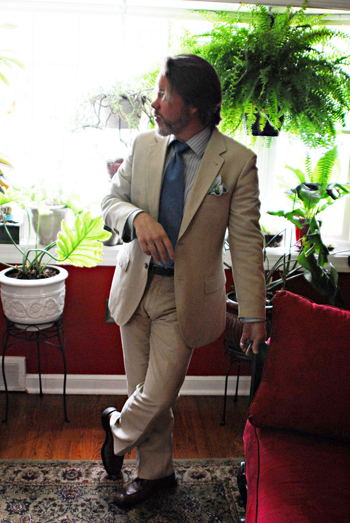 LW: That’s what Weird NJ does, too. It’s a vernacular folklore. Of course, all folklore is vernacular. It’s exactly what I’m up to, really. It’s a strange little tightrope: you don’t want to be too overmediated, because if you become too exposed you just become another person and no one really benefits from that. You try to cultivate a little bit of distance between you and other people, and the Internet is becoming an ideal way of doing that. Text is the same thing, but even more distant. If I were on T.V., it would all break down.
LW: That’s what Weird NJ does, too. It’s a vernacular folklore. Of course, all folklore is vernacular. It’s exactly what I’m up to, really. It’s a strange little tightrope: you don’t want to be too overmediated, because if you become too exposed you just become another person and no one really benefits from that. You try to cultivate a little bit of distance between you and other people, and the Internet is becoming an ideal way of doing that. Text is the same thing, but even more distant. If I were on T.V., it would all break down.
Giving yourself a ridiculous persona allows you to do the things you would otherwise do and get a black eye for. If I were just some guy walking around, riding a highwheel around, people would want to know who I thought I was. But put a playful veneer on it, people say, “Oh, that’s just Whimsy.” It invites them in to play with you.
That’s where I make the narcissism element known. The healthier kind of narcissism is more out in the open and more at your own expense. I’m out there in a loud suit walking around, but you know what, your life is more colorful because I’m doing this, even if I do get a black eye for doing it. It’s got to be done by someone. It’s a shame that it has to be done by a middle-aged guy like me. It should be some 22-year-old kid doing it, but they’re playing it safe. They don’t want to be thought “uncool.”
JA: I’m sure Weird NJ readers generally know what a dandy is, but some might not look at it in the most positive way.
LW: I think a lot of it is just the American puritanical reflex toward any kind of affectation or pretension, which is funny when you hear people in the most developed nation on earth having a hard time with the idea of pretense. That’s the whole point of civilization: pretense. The guy who thinks he’s not being pretentious is the most self-deluded person on the damn block.
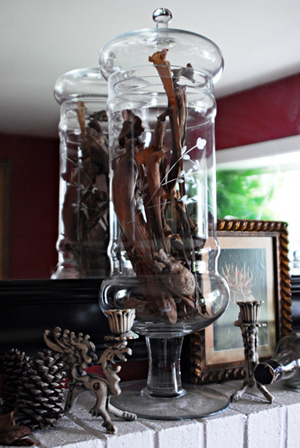 I like toying with dandyism, but I take from dandyism what I need and I leave the rest alone. A real dandy probably wouldn’t say please or thank you or smile. A real dandy probably would want to be a toffee-nosed prick who makes you feel small.
I like toying with dandyism, but I take from dandyism what I need and I leave the rest alone. A real dandy probably wouldn’t say please or thank you or smile. A real dandy probably would want to be a toffee-nosed prick who makes you feel small.
As far as the class thing, it’s meant to please other people, not to make other people feel small. I’d feel bad if what I did made other people feel less about themselves, or if it gave the impression that I was trying to make myself. These are the things that I like; these are the textures that I like. This is the context in which I like to put my life.
You don’t have to select from the pre-set archetypes that are out there, like the “Bad Boy” or the “Solid Citizen.” But of course, if you try to build yourself up from scratch, there’s a price to be paid for that…it’s a dangerous thing and people don’t understand because it doesn’t fit any of the preconceived little archetypes floating around out there. Those little brackets…it’s just lazy thinking. When you’re doing this, you’re forcing people to create a new context around you.
JA: And they don’t want to think.
LW: There are no quotation marks around you: I’m a “rock guy,” an “academic,” a “politician,” a “hipster,” an “artist,” a “leftist.” I parody those things, and that’s what gets people upset, because it’s a wrench in the gears. But I don’t try to be. It isn’t something that you set out to do; it’s something you wind up observing just through your own…
RD: It just happens.
LW: It just happens. I didn’t sit back in the year 2000 and plot all that out. It isn’t that calculated. I’ve just had enough guts to do what I wanted to do. When I was doing the normal guy thing, I felt like I was normal guy drag, just to get along. I got to a point where I didn’t feel like doing it any more. It didn’t feel like me. These textures are missing from society right now.
I can’t go to the bar at the end of the block. I get stared at, and they wonder what the hell I’m doing there. I don’t belong there. So it’s a little more of a selective existence that you have to go about.
 Now I’m finding that there’s a whole subset of people who are into this dandy thing. I’m just as guilty as the next person, it’s just that there’s less of me. So I can’t get on my high horse about this all too much now, can I? I guess it’s just human nature after a certain point. Not to be defeatist but even if that happens, those brackets growing out there allow me to do what it is that I do. I don’t really identify with any of that. I’m off on my own thing. I’m not like some steampunk kid.
Now I’m finding that there’s a whole subset of people who are into this dandy thing. I’m just as guilty as the next person, it’s just that there’s less of me. So I can’t get on my high horse about this all too much now, can I? I guess it’s just human nature after a certain point. Not to be defeatist but even if that happens, those brackets growing out there allow me to do what it is that I do. I don’t really identify with any of that. I’m off on my own thing. I’m not like some steampunk kid.
I’m not into nostalgia. I use something because I like its textures. I have a highwheel not because it’s old, but because there’s something interesting about its qualities. The fact that it’s a sculpture: It’s got ribs, it’s got arcs, it’s quiet, it has a certain restrained beauty to it. It’s something that a human being can use to propel himself through a landscape. Just the fact that it’s old isn’t enough. It’s an interesting context, but it’s just not compelling enough.
It’s the same thing with my parlor out front. That’s pop art, that’s not me trying to live in an earlier time. I think a lot of people look at the book and misconstrue it as that. I’m playing with the forms but the conceit is very modern.
JA: Lucy the Elephant was somewhat of a beacon in your childhood?
LW: She was something. In South Jersey she was a totem. Here was something that shouldn’t even be around any more. There were originally three: one—the Light of Asia down in Cape May—burned down, and then there was the Elephantine Colossus up in Coney Island that was twice as tall as Lucy. Ten years after they built it, it just burned down to the ground. Lucy was the first one, and the only one remaining. It’s a much-beloved totem now—but can you imagine anyone trying to build something like that today, in that neighborhood, with those property values? There’s no way in hell. “Oh, it’s tacky, it’s tasteless”: But what the hell does anyone with vinyl siding on their house know about taste? It’s amazing that something so expensive can look so cheap. I’d rather live in Lucy than in one of those God-awful things.
It’s interesting to see people who have problems with those kinds of things… Exuberance is being so suppressed right now. Unless it’s beige or grey, people don’t want to have anything to do with it.
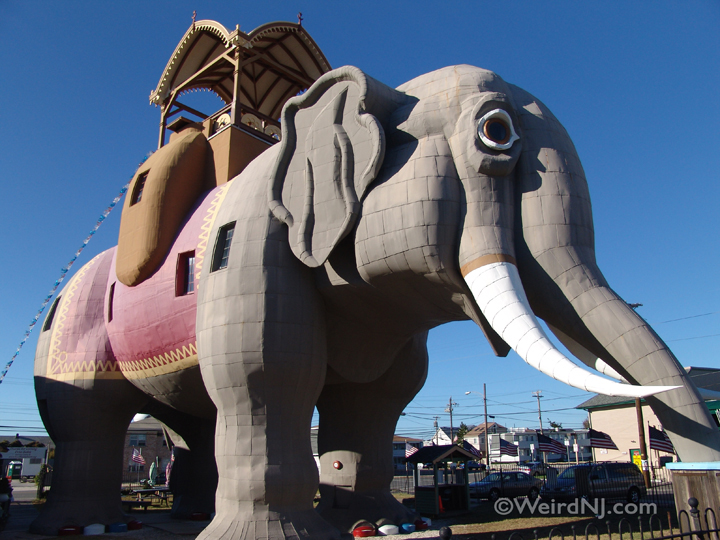
RD: I think that’s why so many “Personalized Properties” pop up.
LW: Sometimes rarity can make things tasteful, can give things that otherwise are overstated and completely out of proportion a kind of grace. We’re in one of those periods right now. Back in the ‘70s, would the Pink Lady of Metuchen really be standing out that much? There were Pink Ladies of Metuchen everywhere then. It was a wonderful time to have been a tacky person. But now we’re in a time when people like that are very much rare beasts, kind of like unicorns.
Lady Pinkwater: Pink unicorns.
JA: There are two pink ladies.
LW: Yes, there are two pink ladies, aren’t there? They’re like a Sith. You should ask which one of them is the master.
LP: They could have a pink cage match. That’ll settle everything.
LW: You have the Pink Ladies, but you have the opposite. There’s always the town witch. At least there was in the ‘70s. Back in the ‘70s, there was a woman in Somers Point…
LP: You were afraid to go by her house.
LW: Yes, she had a black Victorian house.
LP: He ducked every time he went by in the car.
LW: Turns out they had dogs and cats and animals in there, there were feces all over the floor, it was actually a really serious thing. But I think their daughter wore a black cape to school every day. Her name was Marsha. People would go (in creepy voice) “Hellooo Marsha…” They were messed up. But kids would ride by, just looking at the black house.
JA: How about local color from a long time ago: Hezekiah Smith.
LW: Oh, Hezekiah Smith. He was originally from Vermont. He actually married while he was there, but he came down here, bought the mansion (now within the Historic Smithfield Park in Eastampton Township – Eds.) and set up a factory, a compound. He was a bigamist: he never fully divorced his wife and kids up in Vermont. He just went back, started an account in their name, put in a lump sum, and said, “Let’s just call it a day.”
He came down here and married a woman named Agnes, who from the photos I’ve seen was a dead ringer for Sherilyn Fenn. He put her through school, she became a medical doctor, and a good one by all accounts, but she died of cancer, I think at the age of 41. He erected a little shrine to her, a statue out there.
In his later years, he got a little bit more eccentric. He had a garden and about five or six young women out there that kept him company and engaged in conversation with him all day. He had a full-time violinist playing, and they would sit there and hang out.
He taught a bull moose to pull a carriage. I think the name of the moose was February, and he would take him into town and cows would leap out of the road and I think people crashed into buildings. He’d scare the hell out of everybody with that bull moose. There are pictures of it out there that you can see.
JA: Are there? Because I was wondering about that and the…
LW: The bicycle railway? The Hotchkiss Bicycle Railway was basically a way for his workers here in Mt. Holly to take the two-mile trip out to his factory. He built bicycles out there. A fellow by the name of Hotchkiss who worked for him devised this rail system. It was basically a rail fence with an iron rail on the top that ran through pastures, creek beds, creeks, woods, all the way through over to where the Mt. Holly firehouse is now. People got on and went gliding over the landscape to work. Could you imagine that as your morning commute? People copied it: there was one down around Ocean City, and I think there were some other ones down by the shore. I don’t know how long they stayed. But it was up for about ten years and then they ripped it out. There’s some talk about trying to get that land corridor back to rebuild it.
There’s an existing rail bike that they have out there. Go out to the main door and there’s a rail bike right there. They found a bunch of the old rail bikes in a barn or attic somewhere here in town a couple of decades ago. There’s somebody out there with a collection of rail bikes.
RD: You’ve got your foot in both worlds. You could say we’re all kind of normal, but we love things, we have a fascination with them. So we’re in both worlds, too. Everyone who’s part of the magazine is.
LW: I’m an enthusiast. I participate in and cultivate people like that but I feel I’m more of a weirdo advocate than a weirdo. Real advocacy in our time: Weirdo justice. It isn’t like I’m one of those people who doesn’t realize that what he’s doing is strange. And I’m not necessarily saying that it’s a better thing or a worse thing, I’m just saying it is what it is.
Author’s Note: This interview was conducted in July 2008 and never published in the print version of Weird NJ. Since then, Lord Whimsy, whose real name is Allen Crawford, has gone on to do many more things, most recently the book, Whitman Illuminated: Song of Myself (Tin House, 2014), in which he painstakingly and beautifully illustrated the poet Walt Whitman’s most famous work. Whitman lived for a time in the Garden State and is buried in Camden, so anyone with an appreciation of lovely words and illustrations, the increasingly rare and heady aroma of new book ink, and the New Jersey connection should enjoy it. Article by Joanne Austin, photos by Ryan Doan.


